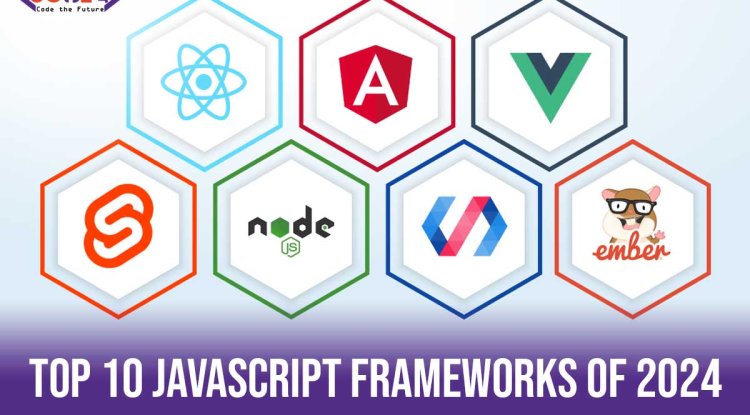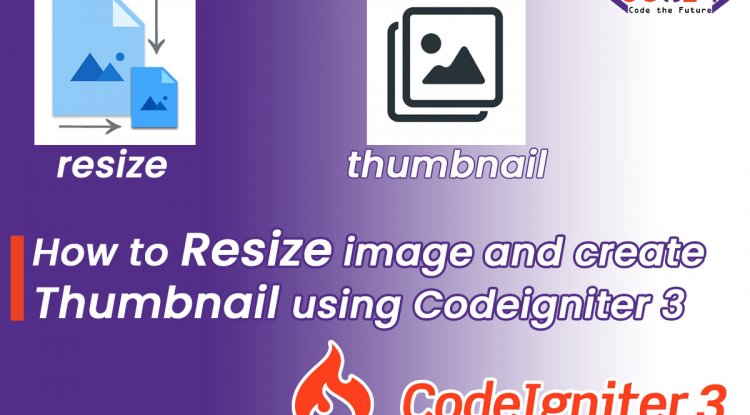Decoding the Code Maze: Your Ultimate Guide to the Top 10 JavaScript Frameworks in 2024!
Embark on a coding adventure with Code24 as we unravel the alphabet soup of JavaScript frameworks! Feeling a bit lost? Fear not, coding comrades! We've got your back. Discover your perfect coding sidekick among the top 10 JavaScript frameworks, set to rock your coding world in 2024. Click to dive into the ultimate guide and elevate your coding journey with Code24's insights! ?? #JavaScriptFrameworks #CodingAdventure

Introduction and Overview of Frameworks
Feeling a bit lost in the JavaScript framework maze, Code24 enthusiasts? It's okay, we've all been there. But fear not, coding trailblazers, because finding the ideal framework is akin to discovering the perfect coding companion for your adventures. So, get ready for an exciting journey, because we're on the verge of unveiling the top 10 JavaScript frameworks set to dazzle your coding experience in 2024! 🚀💻
1. React - Power in Components
Alright, before you interject, I get it—React is a JavaScript library, not a framework! Yet, for countless developers indifferent to the nuance, it remains one of the most beloved JavaScript frameworks! Our journey commences with React, a powerhouse in crafting dynamic and interactive user interfaces. React's revolutionary approach lies in its component-based structure, where applications are constructed as a collection of modular, reusable components. This architecture enhances code reusability, maintainability, and scalability.
Pros of React:
- Community Support: React boasts one of the most vibrant and engaged developer communities globally. This ensures a continuous influx of resources, from third-party libraries to comprehensive tutorials.
- Virtual DOM: React's efficient use of a virtual DOM minimizes the need for direct manipulation of the actual DOM, leading to improved application performance.
- React Native: Beyond the web, React Native allows developers to use React for building native mobile applications.
Cons of React:
- Learning Curve: For beginners, React's component-based architecture may pose a learning curve. Understanding the nuances of state management and props might take time.
- Overhead: The extensive ecosystem might be overwhelming for smaller projects, leading to potential overhead in terms of configuration.
Statistics:
- As of 2023, React remains the most widely used JavaScript library for building user interfaces, with a staggering 8 million developers using it globally.
- Stack Overflow's Developer Survey consistently ranks React as one of the most loved and widely used frameworks.
In essence, React not only empowers developers to create visually stunning interfaces but also sets the standard for how modern web applications are designed and constructed.
2. Vue.js - Versatility in Simplicity
As we navigate through the JavaScript frameworks set to leave an indelible mark in 2024, Vue.js emerges as a notable contender. Vue.js is celebrated for its approachable nature and exceptional versatility, making it an attractive choice for developers, both seasoned and new to the coding arena.
Framework Overview: Vue.js - Bridging the Gap
Vue.js, often referred to as "The Progressive JavaScript Framework," is characterized by its simplicity and ease of integration. This framework adopts a gradual approach to integration, allowing developers to use as much or as little of its features as needed. This adaptability makes Vue.js an excellent choice for projects of varying scales.
Pros of Vue.js:
- Gentle Learning Curve: Vue.js stands out for its gentle learning curve, making it particularly appealing to beginners in web development.
- Versatility: Vue.js offers a flexible and modular architecture, allowing developers to integrate it into existing projects without the need for a full rewrite.
- Documentation: The comprehensive and well-organized documentation of Vue.js facilitates smooth onboarding and troubleshooting.
Cons of Vue.js:
- Smaller Ecosystem: While Vue.js has a growing community, it is smaller compared to giants like React. This might result in fewer third-party libraries and resources.
Statistics:
- According to the State of JS survey, Vue.js consistently ranks as one of the most loved frameworks among developers.
- Vue.js has witnessed substantial growth, with over 2 million developers using it globally.
In essence, Vue.js shines as a framework that bridges the gap between simplicity and functionality, making it a strong contender in the evolving landscape of web development.
3: Angular - Robust Architecture for Enterprise Solutions
Our exploration of JavaScript frameworks continues with Angular, a comprehensive framework backed by Google. Angular stands out for its robust architecture, making it a preferred choice for developers embarking on enterprise-level projects.
Framework Overview: Angular - Beyond Basics
Angular's appeal lies in its full-featured approach, providing an extensive set of tools and features for building large-scale applications. It incorporates TypeScript, a statically-typed superset of JavaScript, bringing enhanced structure and scalability to projects.
Pros of Angular:
- Full-Featured: Angular is equipped with a comprehensive set of tools, making it an all-in-one solution for building complex and feature-rich applications.
- TypeScript Integration: TypeScript enhances code quality by adding static types, reducing errors and improving maintainability.
- Strong Community Backing: With Google as its backer, Angular enjoys strong community support, ensuring continuous development and updates.
Cons of Angular:
- Learning Curve: Angular's extensive features contribute to a steeper learning curve, especially for those new to web development.
- Development Time: While Angular is powerful, building with it may require more development time compared to more lightweight frameworks.
Statistics:
- Stack Overflow's Developer Survey consistently places Angular among the most used frameworks globally.
- Many large enterprises, including Microsoft, IBM, and Google, use Angular for their web applications.
In essence, Angular caters to the needs of developers working on expansive projects, providing a robust and scalable architecture that aligns with enterprise-level requirements.
4: Svelte - Compiling a New Path in Front-End Development
As we progress through the exploration of JavaScript frameworks, our attention turns to Svelte, a framework that takes a unique approach by shifting heavy lifting to compile time. Svelte stands out for its efficiency and simplicity, making it an intriguing choice for developers seeking a novel approach to front-end development.
Framework Overview: Svelte - The Compile-Time Maestro
Svelte distinguishes itself by moving much of the framework code to compile time, resulting in lightweight and optimized runtime code. This approach shifts the burden of computation from the client's browser to the build process, leading to faster and more efficient applications.
Pros of Svelte:
- Compile-Time Efficiency: Svelte's compile-time approach results in optimized and lightweight runtime code, contributing to faster-loading applications.
- Easy Learning Curve: Svelte embraces simplicity, making it approachable for both beginners and experienced developers.
- No Virtual DOM: Unlike some other frameworks, Svelte eliminates the need for a virtual DOM, reducing the amount of code required and enhancing performance.
Cons of Svelte:
- Smaller Community: Svelte's community is smaller compared to more established frameworks, which might mean fewer third-party resources.
Statistics:
- Svelte has gained momentum, with an increasing number of developers adopting it for its unique approach.
- The State of JS survey indicates a growing interest in Svelte, showcasing its emergence in the developer community.
In essence, Svelte offers a fresh perspective on front-end development, challenging traditional paradigms and providing an efficient alternative for building modern web applications.
5: Express.js - Streamlining Backend Development
Our exploration into JavaScript frameworks moves into the realm of backend development with Express.js, a minimalist framework designed for building robust APIs and server-side applications. Express.js empowers developers to create scalable and efficient server-side solutions with minimal overhead.
Framework Overview: Express.js - The Minimalistic Powerhouse
Express.js is renowned for its simplicity and flexibility. It provides essential tools for building web applications without imposing a rigid structure, allowing developers to tailor solutions based on project requirements.
Pros of Express.js:
- Minimalistic Approach: Express.js adopts a minimalistic approach, providing just enough features to build powerful server-side applications without unnecessary complexity.
- Middleware Support: Express.js supports middleware, enabling developers to add additional functionality to their applications easily.
- Great for APIs: Express.js excels in building APIs, making it a popular choice for creating backend services.
Cons of Express.js:
- Less Opinionated: Express.js is less opinionated compared to full-fledged frameworks, which might require additional libraries for a complete MVC structure.
- Learning Curve for Beginners: While simpler than some alternatives, beginners might still face challenges understanding certain concepts.
Statistics:
- Express.js remains a dominant force in backend development, with a large number of developers utilizing it for building APIs.
- The framework's lightweight and modular design contribute to its continued popularity.
In essence, Express.js serves as a versatile tool for developers looking to streamline backend development, offering the right balance between simplicity and functionality.
6: Next.js - Elevating React with Server-Side Rendering
As we conclude our journey through the diverse landscape of JavaScript frameworks in 2024, our focus turns to Next.js. Positioned as an extension of React, Next.js introduces server-side rendering and easy deployment options, offering a powerful combination for developers seeking enhanced performance.
Framework Overview: Next.js - React with Superpowers
Next.js builds upon the strengths of React, enhancing the development process with features like server-side rendering (SSR) and straightforward deployment. This extension of React simplifies the creation of dynamic web applications, providing both the efficiency of React and the benefits of SSR.
Pros of Next.js:
- Server-Side Rendering: Next.js enables server-side rendering, improving performance by rendering pages on the server and sending fully rendered HTML to the client.
- Easy Deployment: Next.js simplifies the deployment process, allowing developers to focus more on building features and less on complex deployment configurations.
- Built on React: For developers familiar with React, transitioning to Next.js is seamless, leveraging existing React knowledge and components.
Cons of Next.js:
- May Feel Complex for Beginners: For those not well-acquainted with React, the introduction of server-side rendering might initially feel complex.
- Learning Curve for SSR: Implementing server-side rendering can introduce a learning curve, especially for developers new to this concept.
Statistics:
- Next.js has gained popularity for its SSR capabilities, attracting developers seeking performance optimization.
- Its integration with React and ease of deployment contribute to its growing adoption in the developer community.
7: Nuxt.js - Elevating Vue.js to New Heights
Let's soar to new heights with Nuxt.js, a powerful framework that supercharges Vue.js for server-side rendering and seamless single-page applications. Nuxt.js enhances the development experience by providing conventions and configurations, making it a fantastic companion for Vue.js enthusiasts. With its focus on performance and ease of use, Nuxt.js is set to elevate your Vue.js projects to the next level.
Pros of Nuxt.js:
- Server-Side Rendering: Nuxt.js simplifies server-side rendering, improving performance and SEO for Vue.js applications.
- Convention Over Configuration: Nuxt.js embraces conventions, reducing the need for extensive configuration and enabling rapid development.
- Modular Architecture: Nuxt.js encourages a modular approach, making it easy to organize and scale Vue.js projects.
Cons of Nuxt.js:
- Learning Curve for Newcomers: While beneficial for Vue.js developers, newcomers might find the conventions and configurations initially challenging.
8: Meteor - Unifying Full-Stack Development
Enter the cosmos of Meteor, a full-stack JavaScript framework that unifies front-end and back-end development into a seamless experience. Meteor is designed for rapid prototyping and building real-time applications with ease. With features like hot code reload and a built-in database, Meteor accelerates the development cycle, making it an attractive choice for projects requiring a full-stack JavaScript solution.
Pros of Meteor:
- Full-Stack Integration: Meteor offers a cohesive environment for both front-end and back-end development, streamlining the full-stack development process.
- Real-Time Functionality: Meteor excels in building real-time applications, making it suitable for chat applications, collaborative tools, and more.
- Hot Code Reload: Meteor's hot code reload feature allows developers to see changes instantly without manual refreshes.
Cons of Meteor:
- Opinionated Structure: Meteor follows a more opinionated structure, which might not be suitable for developers who prefer more flexibility.
- Learning Curve for Advanced Features: While easy to start with, mastering advanced features of Meteor might require additional learning.
Buckle up as our exploration of JavaScript frameworks continues to unfold! 🚀💻
9: Nest.js - A Nesting Ground for Scalable Node.js Applications
Our journey leads us to Nest.js, a framework that empowers developers to build scalable and efficient server-side applications with Node.js. Nest.js adopts a modular and structured approach, drawing inspiration from Angular and embracing TypeScript. With its focus on maintainability and extensibility, Nest.js is a valuable tool for crafting robust server-side solutions.
Pros of Nest.js:
- Modular Architecture: Nest.js promotes a modular structure, enhancing code organization and maintainability.
- Built-in Support for TypeScript: Nest.js leverages TypeScript, providing strong typing and enhancing code quality.
- Scalability: With a focus on modular design and scalability, Nest.js is well-suited for building large-scale applications.
Cons of Nest.js:
- Learning Curve for Beginners: The structured nature of Nest.js might pose a learning curve for developers new to server-side development.
- Not Ideal for Small Projects: The framework's features and structure may be overkill for smaller projects with simpler requirements.
10: Apollo Client - Empowering GraphQL in Front-End Development
Our exploration concludes with Apollo Client, a powerful framework tailored for front-end developers working with GraphQL. Apollo Client simplifies data management and state handling in GraphQL-powered applications, offering a robust and efficient solution for developers navigating the GraphQL ecosystem.
Pros of Apollo Client:
- Efficient Data Handling: Apollo Client streamlines data fetching and management in GraphQL applications, enhancing performance.
- Integration with UI Libraries: Apollo Client seamlessly integrates with popular front-end libraries like React and Angular, providing a smooth developer experience.
- Caching and State Management: Apollo Client includes built-in caching mechanisms and state management for optimized data handling.
Cons of Apollo Client:
- Learning Curve for GraphQL: Developers new to GraphQL may face a learning curve when getting started with Apollo Client.
- Additional Layer of Abstraction: Some developers might find the additional layer of abstraction introduced by Apollo Client to be a matter of personal preference.
Our JavaScript framework odyssey reaches its destination, but remember, the coding adventure is an ever-evolving journey. Happy coding! 🌐💻
Conclusion: Navigating the Dynamic Landscape of JavaScript Frameworks in 2024
In this captivating journey through the ever-evolving world of JavaScript frameworks, we've unveiled the power and potential each framework holds for developers in 2024. As you embark on your coding adventures, armed with the knowledge of React's component prowess, Vue.js's versatile simplicity, Angular's robust enterprise solutions, Svelte's innovative compile-time approach, Express.js's backend magic, and Next.js's elevation of React, we invite you to be part of the code24.in community.
At code24.in, our mission is to not just inform but to inspire and engage our readers. If this exploration has sparked ideas, ignited curiosity, or simply left you intrigued, we encourage you to share the post with your fellow developers, friends, and anyone passionate about the art of coding. Your share might be the guiding light for someone seeking insights into the dynamic landscape of web development.
But our journey doesn't end here; it's just the beginning. We thrive on the energy of our vibrant community. Connect with us on social media — like, share, and comment. Your thoughts and experiences are not just valued; they're celebrated. Let's build a community where knowledge flows freely, and innovation knows no bounds.
Follow us on our social media handles for the latest updates, interactive discussions, and sneak peeks into what the future holds for web development. Together, let's make code24.in not just a platform but a dynamic hub where ideas flourish, and the coding community thrives.
Thank you for being part of this exhilarating journey through the realms of JavaScript frameworks. Your support fuels our passion, and together, we'll continue shaping the future of web development.
Happy coding, and let's build something extraordinary together!
What's Your Reaction?
 Like
0
Like
0
 Dislike
0
Dislike
0
 Love
0
Love
0
 Funny
0
Funny
0
 Angry
0
Angry
0
 Sad
0
Sad
0
 Wow
0
Wow
0













































